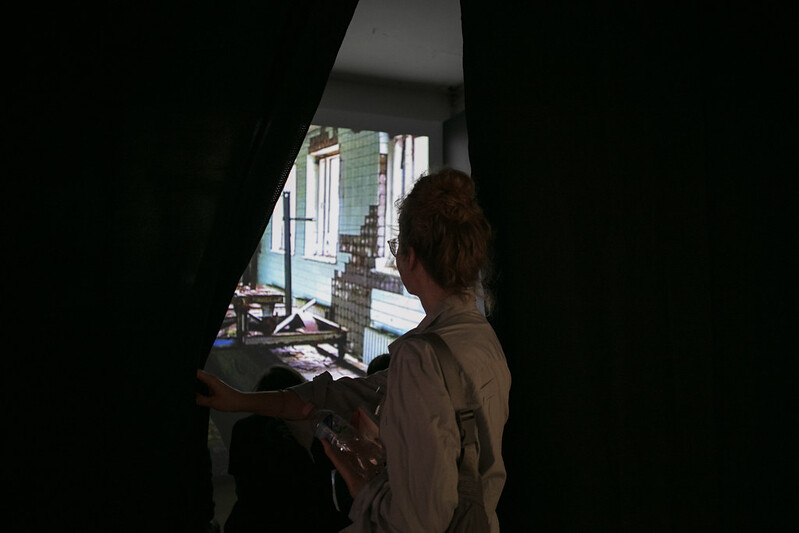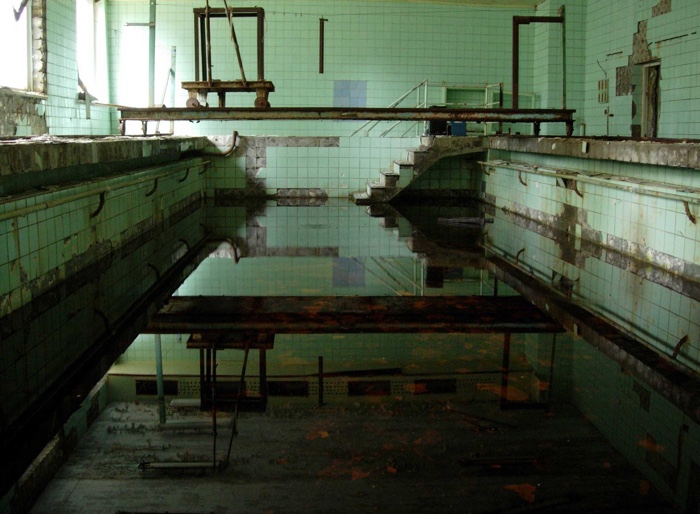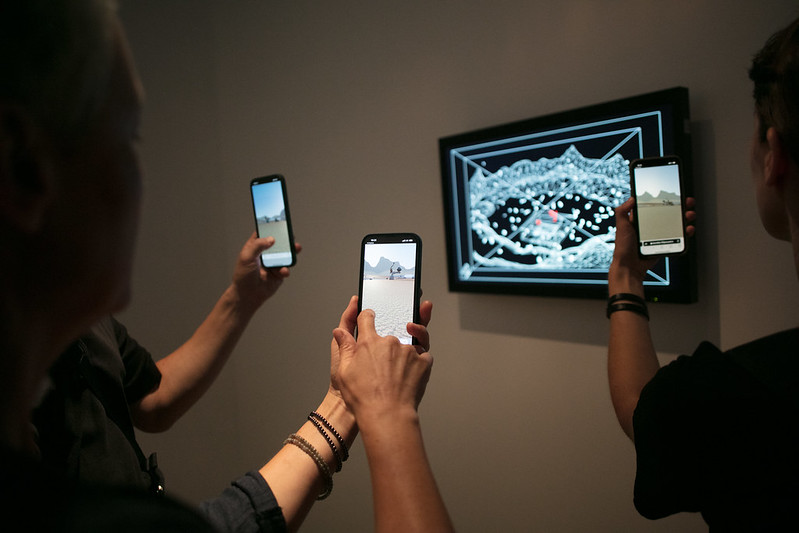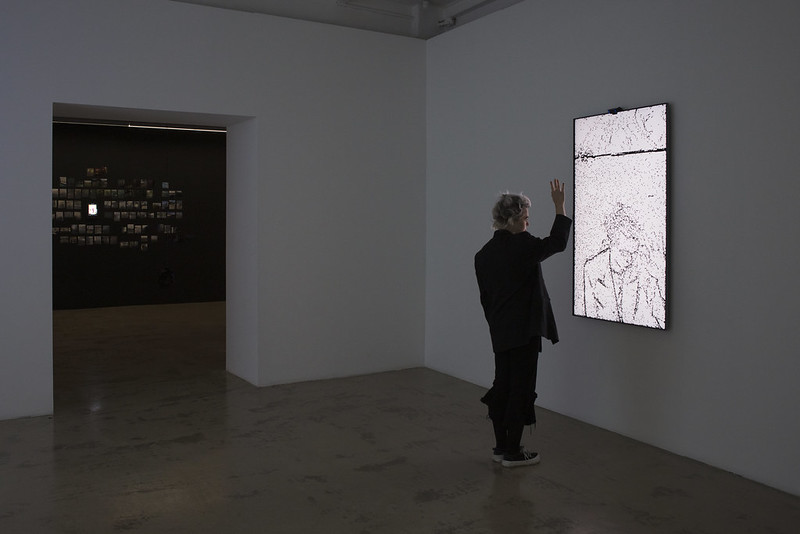Memo Akten, All Watched Over By Machines Of Loving Grace / Deeper Meditations #1-#6, 2021
Splintered Realities. RIXC Art Science Festival 2022. Photo by Juris Rozenbergs
When working on a possible theme for this year’s edition of the RIXC Art Science festival, curators Rasa Smite and Raitis Smits had to contend with a world that changes faster than our brains can process.
As in previous years, the festival exhibition presents the work of artists who look at contemporary world processes from a techno-ecological perspective. The reality they have to grapple with, however, is more fractured and contested than ever: growing social inequalities, pandemic anxieties, deepening political dissensions, concerns about algorithms’ omnipresence, alternative truths boosted by social media, etc. And then there’s the war. RIXC takes place in Riga and because Latvia’s biggest neighbour is Russia, the reality of a war taking place in Europe is far more urging there than in the Western part of Europe where I live. In Riga, you see anti-war and anti-Putin protest signs everywhere. On the window of coffee shops, in front of the Russian embassy, on the outside wall of the Medicine Museum, etc.
All of the above convinced the curators that it would be sensible to follow a transversal thread rather than a well-defined theme. The artworks selected for the exhibition explore the many challenges of our contemporary condition and reflect on a reality punctured from all sides. Not to commiserate on the state of the world but to stimulate discussions about how we can build a new reality from these Splintered Realities. The 5th RENEWABLE FUTURES Conference, also titled Splintered Realities, starts next week. It will take place both in Riga and online. In the meantime, here are some of the artworks I found most interesting:
Mario Klingemann, Neural Decay_4257, 2017
Mario Klingemann, Neural Decay_6117, 2017
Mario Klingemann, Neural Decay, 2017. Splintered Realities. RIXC Art Science Festival 2022 Exhibition. Photo by Kristīne Madjare
Neural Decay is a series of portraits generated by a sequence of custom-trained generative adversarial networks (GANs). The portraits convey the kind of uncanny feeling 19th Century people could experience when looking at spirit photography. At the time, photographers experimenting with new effects quickly realised that mere accidents or techniques such as stereoscopic images and double exposure could generate images where dead relatives and supernatural beings appeared to be hovering over the subjects they were portraying.
Klingemann’s portraits are ambiguous. Their otherworldly appearance is both alluring and daunting. These faces are not entirely human. The ones with the large round eyes reminded me of the human faces of the year 102013. Others seem to wear the kind of mask you encounter in horror movies. Unlike the famous examples of AI that generate human faces that are indistinguishable from real ones, Neural Decay faces show the true nature of the interaction between an artist and a machine: bizarre, clever and never entirely predictable.
Opening of the Splintered Realities exhibition. RIXC Art Science Festival 2022. Photo by Kristīne Madjare
Jacob Kirkegaard, AION, 2006
AION is a Hellenistic deity associated with time. Not the linear, progressive and historical time that Chronos represents but a time that is perpetual, ritual and cyclic. It is an infinite loop covering a time span that extends beyond human understanding, much like the rate at which a radioactive element decays. Jacob Kirkegaard‘s AION is a portrait of four abandoned spaces inside the Chernobyl Exclusion Zone: a swimming pool, a concert hall, a gymnasium and a village church. Each has that kind of mouldy atmosphere that fascinates tourists in search of ruin porn and artists on the lookout for uncanny areas of investigation.
In each of these four spaces, the artist put up a microphone and a speaker. He then started the recording and left. He returned 10 minutes later, stopped the recording, played it back in the same space and made a new recording. He repeated the process until the many layers of sounds found in a room that, at first, sounded silent, merged into one sound with subtle rumbles, whirs, crackles and other overtones… He had captured the voice of the room itself.
AION was inspired by I am sitting in a room, a 1969 sound artwork in which Alvin Lucier recorded himself saying a text, playing it back and re-recording it. He repeated the process until his words were unintelligible, replaced by the characteristic resonant frequencies of the room itself. Kirkegaard didn’t record his voice. He let the four abandoned spaces “speak” for themselves.
Memo Akten, All Watched Over By Machines Of Loving Grace / Deeper Meditations #1-#6, 2021
Memo Akten, All Watched Over By Machines Of Loving Grace / Deeper Meditations #1-#6, 2021. Splintered Realities. RIXC Art Science Festival 2022 exhibition. Photo by Kristine Madjare
Memo Akten, All Watched Over By Machines Of Loving Grace / Deeper Meditations #1-#6, 2021
Memo Akten, All Watched Over By Machines Of Loving Grace / Deeper Meditations #1-#6, 2021
I like to think (and
the sooner the better!)
of a cybernetic meadow
where mammals and computers
live together in mutually
programming harmony
like pure water
touching clear sky.
These are the opening words of Richard Brautigan’s 1967 poem, All watched over by machines of loving grace. Memo Akten’s film of the same name continues his research into the use Deep Neural Networks for creative expression. It puts in images of a world where the boundaries between natural and artificial, between human and technological merge seamlessly. We are supposed to aspire to that fusion, it will augment our body, optimise our lives and advance society. However, the artist notes, the borders between ‘nature’ and ‘artificial’ are fictitious therefore “our efforts to tame nature and subdue her to our will, are in fact an endeavor to tame and imprison ourselves.”
The experimental film lasts 4 minutes but I watched it over and over. In part because the metamorphoses of a human face to pure eeriness are infinitely seducing. In part, because I kept wondering at what point exactly I felt that the mutually programming harmony was turning a bit sour.
The short film is also a fable about our idolisation of technology. The gods who used to keep an eye us from Mount Olympus have been replaced by machines which, under their supposed neutrality, are no less intrusive than the deities of Ancient Greece. In our race to computerise and ‘progress’, we often fail to diagnose the consequences that any failure in our judgement will have.
Sahej Rahal, finalforest.exe, 2021. Splintered Realities. Press Conference. RIXC Art Science Festival 2022. Photo by Juris Rozenbergs
Sahej Rahal, finalforest.exe, 2021
There is something incredibly touching (and perhaps more human than in Mario Klingemann’s portraits) in the creature that roams, all alone, in the lush landscape of Sahej Rahal‘s finalforest.exe. When you stand near the microphone and start speaking or making noise, the amorphous creature spits out fumes. Toxic-looking and black like coal, the fumes establish a bridge between the purely virtual, 21st-century creature and the deep-time geological origin of its digital existence.
You don’t get to hear the story of the creature: is it wandering in a landscape that existed long before homo sapiens appeared? Or is it exploring a nature that is thriving centuries after humans caused the collapse of their civilisation? All you know is that the creature is driven by AI scripts that are attached to its “calcified petroleum body.”
Alvis Misjuns, Peace on Web, 2022. Splintered Realities. Press Conference. RIXC Art Science Festival 2022. Photo by Juris Rozenbergs
Alvis Misjuns, Peace on Web, 2022
Alvis Misjuns, Peace on Web, 2022. Opening of the Splintered Realities exhibition. RIXC Art Science Festival 2022. Photo by Kristīne Madjare
Peace on Web is a virtual space created by Alvis Misjuns to allow people to escape from influencers, clickbait articles, trolls, ads and other obnoxious matters of digital life. Your friends and new acquaintances can join you and hang out on the platform. They will be assigned an avatar that fits quietly into the environment. A branch, for example. Or a twig, a rock, a leaf, etc. In line with their inanimate persona, your friends won’t be able to have verbal or text communications with each other. The only way they can interact is by moving through the space.
Peace on Web was conceived in reaction to the attempts by Silicon Valley companies to create a metaverse that will only keep us trapped inside the mechanisms of capitalism.
Hayoun Kwon, 489 Years, 2016 (excerpt)
489 Years is an animated film based on the testimony of a former South Korean soldier who used to be stationed in the DMZ that separates North and South Korea.
In the absence of human activity, between the guard towers, the fences, the barbed wires and the walls, there are streams and hills as well as animals and plant species that thrive in the strip of land that divides the Korean Peninsula in two.
The gamer’s FPS (first-person-shooter) perspective and the personal narrative recreate the feeling of a place inhabited by both unique biodiversity and anxiety caused by landmines and other invisible dangers.
It has been estimated that it would take 489 years to demine that no man’s land.
Other works and images from the show:
Theo Triantafyllidis, Radicalization Pipeline, 2021. Splintered Realities. RIXC Art Science Festival 2022 Exhibition. Photo by Kristīne Madjare
Theo Triantafyllidis, Radicalization Pipeline (extract), 2021
Sabīne Šnē, Grey Gold, Black Lakes, White Latex, 2022. Splintered Realities. RIXC Art Science Festival 2022 exhibition. Photo by Kristine Madjare
Debbie Ding / DBBD.SG, Void, 2021. Splintered Realities. Press Conference. RIXC Art Science Festival 2022. Photo by Juris Rozenbergs
Allison Stewart, Daisy’s Bug Out Bag from the series Bug Out Bag, 2016
Daisy is a trained Disaster Dog. She is trained to help her family in an emergency situation, including search and rescue. She carries supplies for herself as well as for her family. The book Family Disaster Dogs is available online for $3.49.
Opening of the Splintered Realities exhibition. RIXC Art Science Festival 2022. Photo by Kristīne Madjare
Splintered Realities. RIXC Art Science Festival 2022 exhibition. Photo by Kristine Madjare
Laurent Mignonneau and Christa Sommerer, Portrait on the Fly, 2015. Opening of the Splintered Realities exhibition. RIXC Art Science Festival 2022. Photos by Kristīne Madjare
Laurent Mignonneau and Christa Sommerer, Portrait on the Fly, 2015. Splintered Realities. RIXC Art Science Festival 2022 exhibition. Photo by Kristine Madjare
Opening of the Splintered Realities exhibition. RIXC Art Science Festival 2022. Photo by Kristīne Madjare
The RIXC Art Science Festival 2022 under the title SPLINTERED REALITIES takes place in Riga and virtually. The Festival Program includes the EXHIBITION (August 25 – October 16, 2022 / Kim? Contemporary Art Center) and the CONFERENCE (October 6–8, 2022 / Hybrid: Virtual / Riga), featuring Deep Europe Symposium, the 5th Renewable Futures conference and Live Sessions from Liepaja, Karlsruhe and Oslo.
Previously: Radicalization Pipeline, Alternative Realities. The ghosts of fallen Russian soldiers, No Man’s Land. Natural Spaces, Testing Grounds, etc.
























